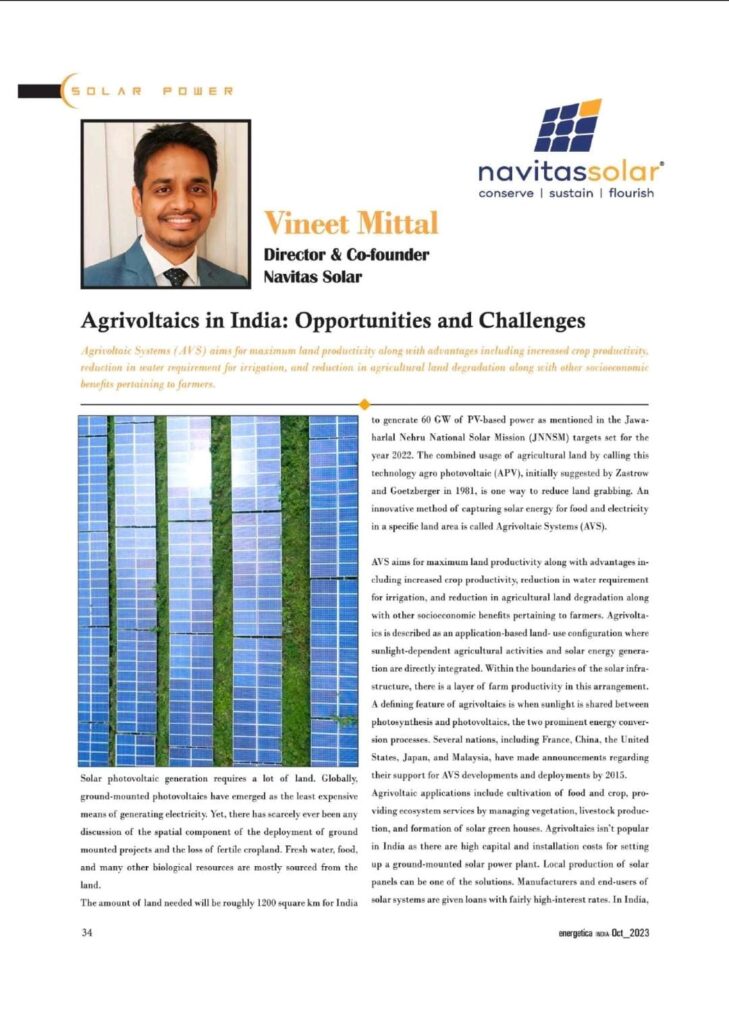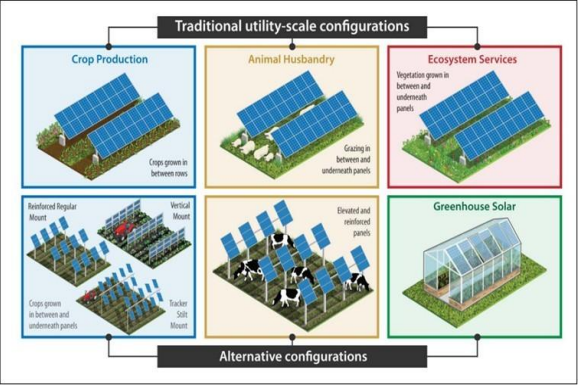Mr. Vineet Mittal: Agrivoltaics in India – Opportunities and Challenges


Solar photovoltaic generation requires a lot of land. Globally, ground-mounted photovoltaics have emerged as the least expensive means of generating electricity. Yet, there has scarcely ever been any discussion of the spatial component of the deployment of Ground mounted projects and the loss of fertile cropland. Fresh water, food, and many other biological resources are mostly sourced from the land.
The amount of land needed will be roughly 1200 square km for India to generate 60 GW of PV-based power as mentioned in the Jawaharlal Nehru National Solar Mission (JNNSM) targets set for the year 2022. The combined usage of agricultural land by calling this technology agro photovoltaic (APV), initially suggested by Zastrow and Goetzberger in 1981, is one way to reduce land grabbing. An innovative method of capturing solar energy for food and electricity in a specific land area is called agrivoltaic systems (AVS).
AVS aims for maximum land productivity along with advantages including increased crop productivity, reduction in water requirement for irrigation, and reduction in agricultural land degradation along with other socioeconomic benefits pertaining to farmers. Agrivoltaics is described as an application-based land-use configuration where sunlight-dependent agricultural activities and solar energy generation are directly integrated. Within the boundaries of the solar infrastructure, there is a layer of farm productivity in this arrangement. A defining feature of Agri- voltaics is when sunlight is shared between photosynthesis and photovoltaics, the two prominent energy conversion processes. Several nations, including France, China, the United States, Japan, and Malaysia, have made announcements regarding their support for AVS developments and deployments by 2015.
Agrivoltaic applications include Cultivation of food and crop, providing ecosystem services by managing vegetation, livestock production, and formation of solar green houses. Agrivoltaics isn’t popular in India there are high capital and installation costs for setting up a ground-mounted solar power plant. Local production of Solar panels can be one of the solutions. Manufacturers and end users of solar systems are given loans with fairly high-interest rates. In India, utility costs for manufacturing facilities are also relatively expensive, which drives up the cost of production. So, it is challenging to persuade farmers to implement the concept of AgriPV on their agricultural land and benefit from it unless the cost of the solar panels is reduced. There are no incentives targeted towards agrivoltaics in India. Many countries such as the United States of America, Germany, Australia, France, China, Spain, and Canada, have provided incentives and are successful in implementing those. These incentives capture the attention of end-users to opt for Agrivoltaics and provided significant acceptance.
There is a lack of information about agrivoltaics in the Indian farming community. The operation and maintenance of any solar power plant need intensive training. So, the Indian government should take proactive measures to inform the farming community on how to deploy agrivoltaics correctly. Moreover, the fear of failure prevents the agrivoltaics strategy from being widely adopted. To help farmers overcome their fear of failure, the Indian government should host training sessions to teach them how to make informed judgments along with informative insurance policies.
On the other hand, if this technology is implemented correctly, Agrivoltaics can provide immense scope for reshaping the future of Renewable Energy in the Indian farming ecosystem. Agrivoltaics’ adoption and success will raise public awareness of the advantages of transitioning to renewable energy sources, especially in rural areas where local villagers feel no need to switch to solar since their daily energy consumption is relatively low. Agrivoltaics can create more electricity, which will lessen the need for coal fired power plants. The concept of agrivoltaics as a source of secondary income generation will decrease livestock dependency and reduce GHG emissions.
Here are some famous Agrivoltaic Plants of India which can be inspiration for many to install in future.
| Sr. No. | Project Name, Location | Capacity |
|---|---|---|
| 1 | Harsha Abakus, Pandhro | 1.0 MW |
| 2 | Harsha Abakus, Sikka | 1.0 MW |
| 3 | GIPCL, Amrol | 1.0 MW |
| 4 | GIPCL, Vastan | 1.0 MW |
| 5 | Mahindra Susten, Gingurthy | 1 MW |
| 6 | Agrivoltaics Plant Parbhani, Maharashtra | 1.4 MW |
| 7 | SunMaster | 2.5 MW |
| 8 | Abellon | 3 MW |
| 9 | Cochin International Airport Solar Farm | |
| 10 | GroSolar | 1 MW (Total 7 MW) |
| 11 | Jodhpur, CAZRI | 105 kW |

There are numerous projects of AgriPV in India as shown. However, there are some unique AgriPV power plants also exist like Fish Pond AgriPV System 30kW and NISE Vertically Installed Bifacial PV Pilot. There are various sturtures in Agri Voltaics too for implementation according to the crop, type of land, season and other parameters.



 Online | Privacy policy
Online | Privacy policy
Related Posts
You May Also Like
Bonito Series: Driving Innovation in…
Read MoreTOPCon Series: The Next Generation…
Read MoreValuable Points to Remember During…
Read MoreNavitas Planet Partners with Hysolwin…
Read MoreDriving Towards a Sustainable Future:…
Read MoreWhy Do Top-Grade EVA Sheets…
Read MoreBonito Series: Driving Innovation in…
Read MoreTOPCon Series: The Next Generation…
Read MoreValuable Points to Remember During…
Read MoreNavitas Planet Partners with Hysolwin…
Read MoreDriving Towards a Sustainable Future:…
Read MoreWhy Do Top-Grade EVA Sheets…
Read MoreBonito Series: Driving Innovation in…
Read MoreTOPCon Series: The Next Generation…
Read MoreValuable Points to Remember During…
Read MoreNavitas Planet Partners with Hysolwin…
Read More